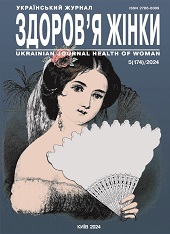Course of the first trimester and the condition of the immune system in pregnant women after application of the assisted reproductive technologies
DOI:
https://doi.org/10.15574/HW.2024.5(174).2630Keywords:
pregnancy, assisted reproductive technologies, cellular immunity, humoral immunity, threatened miscarriageAbstract
Pregnancy, which is a consequence of the assisted reproductive technologies (ART) application, takes place in specific conditions and is accompanied by numerous complications. One of the factors’ causing infertility is disorders in the immune system (IC), which lead to a pregnancy complication.
Aim - to evaluate the course of the first trimester of pregnancy and determine the state of the immune system in women with tubal-peritoneal infertility whose pregnancy occurred application of the ART.
Materials and methods. 94 women with tubo-peritoneal type of infertility, whose pregnancy occurred as a result ART application, who formed the main group and 50 pregnant women with spontaneous onset and physiological course of pregnancy, who formed the control group, were examined. In addition, determination of the immunological link of homeostasis in all women was performed.
Results. In the first trimester of pregnancy in the main group women took place changes in the T-cell IC link, which was reflected in an increase in the number of CD3+ cells and a decrease in the number of CD8+ cells, which indicated the first degree of immune disorders. Examination of the humoral link in the main group pregnant women revealed a decrease in CD22+ cells, an increase in their absolute number together with an increase in the concentration of IgM and decrease in the concentration of IgG.
Conclusions. When analyzing the immune system in pregnant women with tubo-peritoneal type of infertility, a tendency to the formation of immune disorders in both the cellular and humoral links of the immune system due to an increase in the absolute and relative number of T-lymphocytes and a decrease in B-lymphocytes, an increase in the concentration of IgM and a decrease in the concentration of IgG, was established. confirms the activation of cellular and humoral links of the immune system.
The study was conducted in accordance with the principles of the Helsinki Declaration. The study protocol was approved by the local ethics committee of the participating institution. Informed consent was obtained from all patients.
No conflict of interests was declared by the authors.
References
Al'Fanir M. (2022). Tactic of treatment of infertility on a background a chronic urogenital infection for multiparous women. Perinatology and reproductology: from research to practice. 2(2): 72-77. https://doi.org/10.52705/2788-6190-2022-02-11
Berestoviy OO. (2022). Women have comparative aspects of clinical motion of pregnancy and births with the united forms of infertility. Perinatology and reproductology: from research to practice. 2(4): 5-13. https//doi.org/10.52705/2788-6190-2022-04-1.
Boichuk OH, Dorofeyeva US. (2020). Contemporary views on female infertility in women of advanced maternal age (literature review). Actual problems of Pediatrics, Obstetrics and Gynecology. 1: 74-79. https://doi.org/10.11603/24116-4944.2020.1.11489
Chen Z, Huang J, Kwak‐Kim J, Wang W. (2023). Immune checkpoint inhibitors and reproductive failures. Journal of reproductive immunology. 156: 103799. https://doi.org/10.1016/j.jri.2023.103799; PMid:36724630
He S, Mao X, Lei H et al. (2020). Peripheral blood inflammatory-immune cells as a predictor of infertility in women with polycystic ovary syndrome. Journal of Inflammation Research. 13: 441-450. https://doi.org/10.2147/JIR.S260770; PMid:32884325 PMCid:PMC7443446
Kicińska AM, Maksym RB, Zabielska-Kaczorowska MA et al. (2023). Immunological and metabolic causes of infertility in polycystic ovary syndrome. Biomedicines. 11(6): 1567. https://doi.org/10.3390/biomedicines11061567; PMid:37371662 PMCid:PMC10295970
Liang C, Hsin-Fang C, Dobson JA et al. (2022). Infertility, miscarriage, stillbirth, and the risk of stroke among women: a systematic review and meta-analysis. Stroke. 53(2): 328-337. https://doi.org/10.1161/STROKEAHA.121.036271; PMid:34983235
Pourakbari R, Ahmadi H, Yousefi M, Aghebati-Maleki L. (2020). Cell therapy in female infertility-related diseases: Emphasis on recurrent miscarriage and repeated implantation failure. Life sciences. 258: 118181. https://doi.org/10.1016/j.lfs.2020.118181; PMid:32763291
Shojaei Z, Jafarpour R, Mehdizadeh S et al. (2022). Functional prominence of natural killer cells and natural killer T cells in pregnancy and infertility: A comprehensive review and update. Pathology-Research and Practice. 238: 154062. https://doi.org/10.1016/j.prp.2022.154062; PMid:35987030
Solovei VM. (2021). Prediction of perinatal complications in women with noncarrying of pregnancy at early gestation terms (Literature review). Clinical and experimental pathology. 20. 3(77): 96-105. https://doi.org/10.24061/1727-4338.XX.3.77.2021.14
Tetik S, Ahmad S. (2023). The role of expressed T-cellscytokines mRNAs from endometrial tissue in patients with unexplained infertility. Indian Journal of Biochemistry and Biophysics (IJBB). 60(5): 406-413. https://doi.org/10.56042/ijbb.v60i5.1224
Upadhyay Y, Chhabra A, Nagar JC. (2020). A women infertility: an overview. Asian Journal of Pharmaceutical Research and Development. 8(2): 99-106. https://doi.org/10.22270/ajprd.v8i2.654
Vdovychenko SYu, Zhuk SI, Salnikov SM. (2021). Obstetric and perinatal aspects of retrochorial hematomas. Reproductive health of woman. 7-8(52-53): 51-56. https://doi.org/10.30841/2708-8731.7-8.2021.250834
Vygivska LM, Beniuk VO, Oleshko VF et al. (2023). Analysis of perinatal consequences against the background of the proposed treatment complex in pregnant women after the application of assisted reproductive technologies. Reproductive health of woman. 8(71): 39-46. https://doi.org/10.30841/2708-8731.8.2023.297793
Downloads
Published
Issue
Section
License
Copyright (c) 2024 Ukrainian Journal Health of Woman

This work is licensed under a Creative Commons Attribution-NonCommercial 4.0 International License.
The policy of the Journal UKRAINIAN JOURNAL «HEALTH OF WOMAN» is compatible with the vast majority of funders' of open access and self-archiving policies. The journal provides immediate open access route being convinced that everyone – not only scientists - can benefit from research results, and publishes articles exclusively under open access distribution, with a Creative Commons Attribution-Noncommercial 4.0 international license (СС BY-NC).
Authors transfer the copyright to the Journal UKRAINIAN JOURNAL «HEALTH OF WOMAN» when the manuscript is accepted for publication. Authors declare that this manuscript has not been published nor is under simultaneous consideration for publication elsewhere. After publication, the articles become freely available on-line to the public.
Readers have the right to use, distribute, and reproduce articles in any medium, provided the articles and the journal are properly cited.
The use of published materials for commercial purposes is strongly prohibited.

